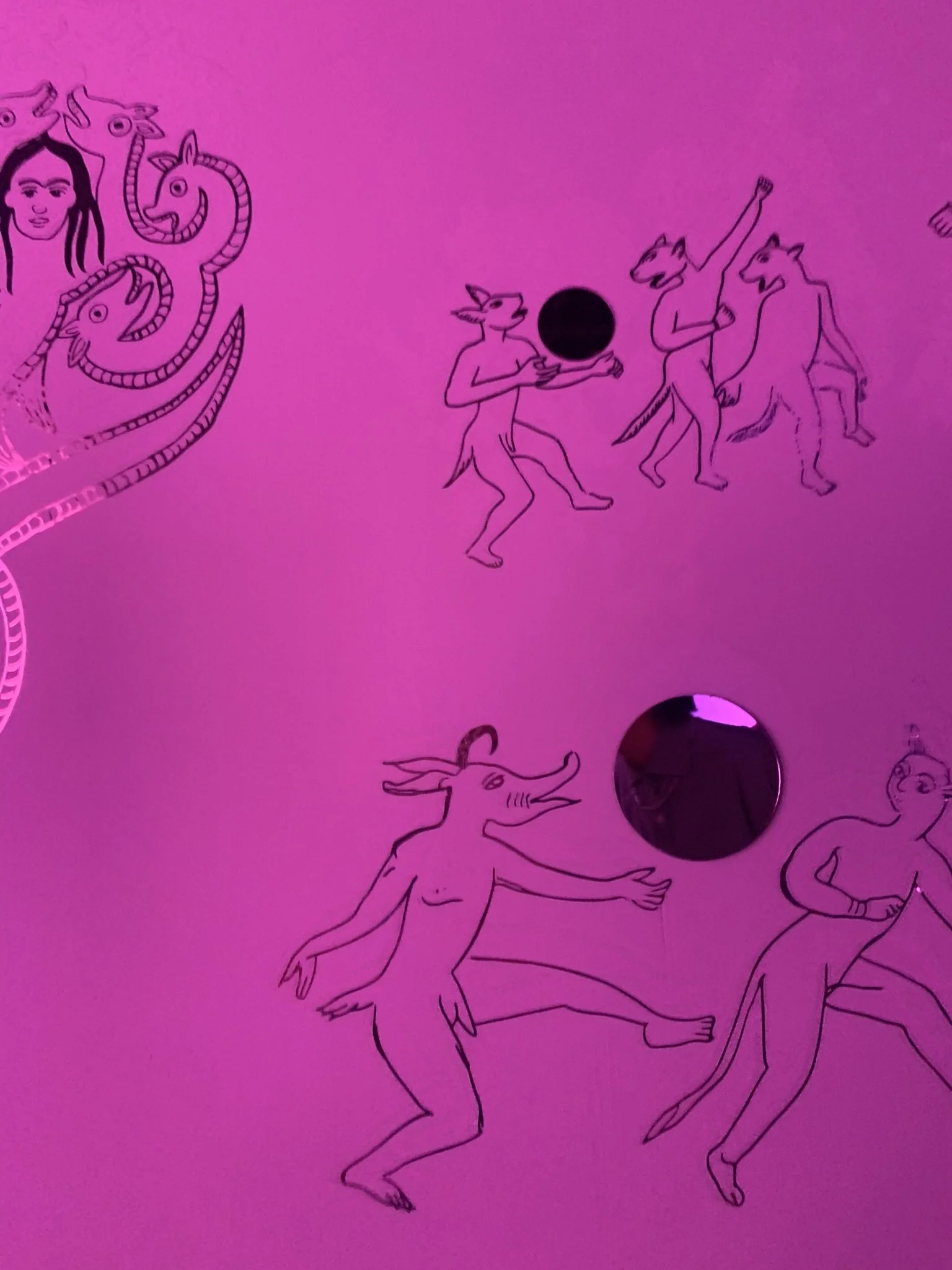On for the sake of dancing in the street
The corner of the exhibition is a bedroom, built by Yasmine Nasser Diaz. Call it what you may––the imagined adolescent bedroom, a first-gen, third culture, daughter of immigrants bedroom. A Free Palestine tote, television set on, trinkets blending cultures and geographies. We, the daughters of the diaspora, know it well.
*
We live in a between state, a temporary land merging here and there. The artist’s bedroom installation takes this duality further––on the television are clips from the Arab Spring, while projected onto one wall are TikToks and short videos of women and queer people dancing. In the bedroom, past meets present.
Movement, violence, bodies in all their capacities. Our bedrooms are spaces where we try to make sense of ourselves, and what it means to be women. Or really, any gender––what it means, I think, more accurately, to live beneath patriarchy.
Image by Tracy Nyguyen
*
I am 23 years old. A recent college graduate flailing at a media desk job, desperate for community. The Feminist Center for Creative Work comes on my radar, and I scour the website and social media searching for how I can be involved. I soon receive a message––a call for volunteers. Their new artist in-residence will be installing their work, and they need extra hands. I email back right away and sign up.
When I arrive, I find two other volunteers who seem to know each other, and the artist herself––Yasmine Nasser Diaz. The area is a semi-spacious room (then at FCCW’s Frogtown space) and I am to install pink wallpaper. I say I have done this before, although I haven’t. I see the objects around me, and feel familiarity.
I didn’t know art could feel like spaces I knew. I think about this for a long time.
*
I know from a young age what I am supposed to do. Follow the traditions of my culture set before me. Be a woman of faith. A woman of grace and modesty. Marry well. Make a family.
I am 26 years old when I call off my wedding. Everyone is shocked and in a way heartbroken. I am not heartbroken. I am just sad at all the pain I’ve caused. I dared to utter the word queer and the whole façade of what should have been came crumbling down.
What does it mean to be a woman? I don’t know, I still feel like a girl. A girl who has just discovered love, and bodies, and that they can be so many other things.
*
Un violador en tu camino is a protest chant. A rapist in your path. Or, the rapist is you.
for the sake of dancing in the street has a whole room dedicated to tracing iterations of this chant’s performances. It was first performed by activist group LASTESTIS in Chile in 2019, protesting violence against women. And in the few years since, women around the world have translated it into their language, staging chillingly uniting public performances, eyes covered in black cloth, fists in the air. I look up the lyrics and the words are relatable, urgent, almost hard to read. Necessary.
*
I come from two patriarchal cultures––my mother is from Mexico and my father is from Egypt. Both countries––both Arab and Latinx culture as a whole––are still deeply attached to traditional gender roles. But it’s never that simple. for the sake of dancing in the street illustrates the fierce feminist movements born out of these cultures, happening today. None of this is a lost cause.
Each year, family members and friends in Mexico attend 3J, a public march against femicide and gender-based violence. Alongside hundreds of thousands of others, they chant Ni una menos. Like music, the words fill the streets. My cousins rage, cry, scream, sing, dance.
*
Image courtesy of the author
I am 28 years old. The opening of for the sake of dancing in the streets electric. To celebrate feminist and queer resistance is an act of kinship, a pervasive joy pulsing through the room via a rotating disco ball, pink wallpaper and Morehshin Allahyari’s shimmering vinyl cutouts on either side, with an additional room tracing the global phenomenon of women refusing to be silenced.
Yet this joy is inextricable from anger. This exhibition exists because we are angry. This exhibition exists because we continue to grapple with the realities of gender-based violence and its persistent effects. I think about what it means to hold both these emotions at once. I think about the role of artistry. Anger can be a catalyst for such powerful work, but of course I wish the oppressive conditions didn’t exist at all. I think about exhaustion. I think about feminine labor.
There is so much culture-shifting activism that has already been undertaken. There is so far yet to go. We are angry and tired, but for an evening, we gather.
I return to a momentary joy, drink a glass of wine, and revel in the simple magic of being in a room full of people who look like me.
*
I used to think I could not be both/and. Both a lover of my cultural traditions and a fierce feminist, a queer person. It is scary to pave a path when there are no models on the path before you. Getting older has meant realizing that there were, in fact, many models. There still are. They exist in streets, galleries, books, newspapers––they are both nearby and far away.
We have always been breaking molds.
And I will keep doing so, proudly.
*
Sarah Yanni’s writing can be found in SPECTRA, Mizna, SARKA, and others. A Best of the Net Nominee, she was a Finalist for BOMB Magazine’s Poetry Contest and The Andres Montoya Letras Latinas Poetry Prize, among others, and was most recently a Finalist to be the Poet Laureate of Glendale. She is the author of the chapbook ternura / tenderness (Bottlecap Press) and has received support from the Community of Writers and the California Institute of the Arts. She currently serves as Managing Editor of TQR and Poetry Editor of The Dry River.
Editor’s Note: Sarah Yanni is currently employed with LAND, the exhibition's co-presenter, as a Grants Writer. As such, she has been involved with some portions of support for the work.
For the sake of dancing in the street was co-presented by LAND and OXY ARTS, and organized by Yasmine Nasser Diaz


